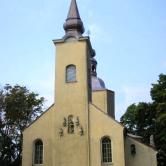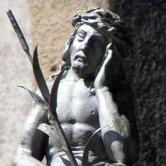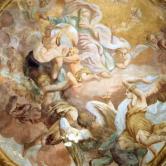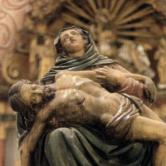Sights > Parish Churches of Our Lady of Koruška and St Mark of Križevci
The Church of Our Lady of Koruška is a unique example of a central building with a trefoil sanctuary, and a cruciform layout. The statue made by Varaždin sculptor Ivan Jakob Altenbach is placed in the centre of the church with a large cupola and a lantern above it. It had been a unique church in Croatia with longitudinal base, a transept and a cruciform layout. The center of the church is lit by chapel windows and semi-circular windows set beneath the cupola. The roof of the church used to be higher, covered with board-and-batten siding.The barrel-vault is shorter and divided in three parts. The bell tower and choir were built additionally in 1872 - 1873, which was a shift away from the original architecture dominated by cruciform shape, with the miraculous statue as its central point.In 1674 Marija Juhrin (Jurčin), the wife of Nikola Makar, the lieutenant-colonel of the fortress, had the statue of Our Lady of Sorrows placed near Koruška stream. After Marija Jurčin died, the statue was torn down. Legend has it that it was at this spot that Martin Hundrić from Križevci was attacked by a band of marauding Turks. He was critically wounded and nearly died, but he made a solemn vow to the Holy Virgin so he survived. With the help of nobleman Mijo Berković he erected the statue and put a little roof above it to shield it. The legend of the miracles performed by the Holy Virgin has grown ever since. When the statue was torn down again during a violent storm, Matija Lončarić erected four pillars to support it and put a roof on top of them. That is how a small outdoor shrine came into existence. The cult of the Holy Virgin was widely spread, so in 1702 Juraj Janković, the parson of Križevci, built a small chapel which was expanded in 1715 with the altars set in it. The present church owes its existence to parson Lovro Starčić who had it built in 1725.
After the Church of Our Lady of Koruška was built, the cupola and culottes were painted al fresco. These murals date from 1726, which is the year inscribed above the arch. Due to years of roof leakage the frescoes were damaged. They were unskillfully restored later on, but the images were retained.The culottes and the cupola are embellished with acanthus, bay leaves, and bell-like fringes. Numerous images of vases with roses and tulips indicate the frescos were painted by the Pauline order painters (such as Ivan Ranger). The culotte frescos depict the Coronation of the Virgin Mary, Resurrection, Holy Trinity, the Ascension of Christ. There are painted niches above the embellished columns, at the corners in which the statues were placed. The frieze section is decorated with circular moldings depicting scenes from The Passion of Christ: Christ in the garden of Getsemany, Flagellation of Christ, Christ being mocked, the Crown of Thorns, Christ Carrying the Cross, Christ Nailed to the Cross, Crucifix, Laying Him in the Tomb. The scenes are highly dramatic and expressive. The Baroque expression and lively coloring were captured on some of the paintings. More skilfully painted decorations can be seen on the cupola. Within one circular molding one can see God with the globe in his hands and the angels around him, their image stretching outside the bay-leaved frame. The paintings in the corners depict scenes from nature or the Old Testament (Moses in the desert, The Brass Serpent). The frescos must have been restored around 1984. The nave is decorated with stuccoed circular moldings, and angel heads.A Solemn Mass held on the New Year's Eve of 2004 marked the opening of the new, long awaited, Parish in Križevci. It was founded on 24th of April, 2004, by a Decree issued by the archbishop of Zagreb, Josip Bozanić. There are two patron saints of this parish: Our Lady of Sorrows (the feast of Our Lady of Sorrows is celebrated on September 15th) and Saint Mark of Križevci (the feast of Saint Mark of Križevci is celebrated on July 2nd).
The chapel was renovated and extended between 1872 and 1873. Another renovation was carried out in 1894, resulting in pulling down the main Baroque altar and setting the altar made by Ferdinand Stuffleser in its place. In 1923 Zagreb City Bureau for the Protection of Cultural and Natural Heritage donated 12 500 dinars for interior and exterior renovation, including the repairing the chapel's roof. Prior to the renovation, the exterior was softer and more colourful. The wall was divided by black pilasters painted on the soft yellow plaster of the wall. The original sacristy door post was preserved. The carvings on the door post indicate that it was made by the same person who carved the doorway of the Church of St Ana. It was at the same period that the construction of the church tower was nearly done, so the constructions and carvers may have been engaged in both of the construction project.The church became famous for the miraculous statue of Our Lady of Sorrows, and was attended by many pilgrims, while Pauline historian Nikola Benger further contributed to its growing popularity by publishing a book in 1730, in which he described all the miracles performed by Our Lady of Koruška.
In 1942, with the support of Zagreb City Bureau for the Protection of Cultural and Natural Heritage (then called The Conservation Institute), the interior was restored into its original appearance. Tyrol altar was removed, while the altar of the Holy Family, previously placed within the nave, was put in its place. There is a valuable __________on it, probably made by the Pauline order painters. The church owes its present exterior appearance to the latest restoration carried out in 2006.





